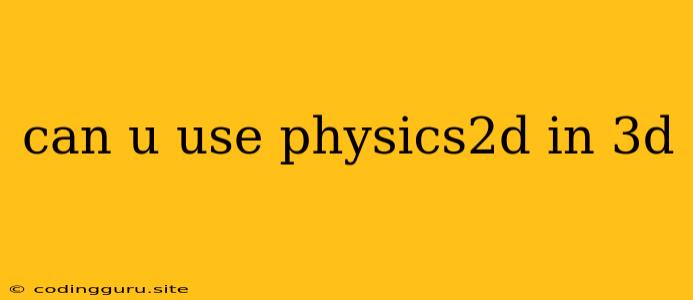Can You Use Physics2D in 3D?
The short answer is no, you cannot directly use a 2D physics engine to simulate physics in a 3D environment. Physics2D systems are designed to work within a two-dimensional plane, handling collisions, gravity, and movement within that space.
However, there are ways to achieve similar results in 3D by leveraging existing 2D physics engines and techniques. Here are a few approaches:
1. Constrained 3D Physics:
- Plane Restriction: Imagine a 3D world where your objects are confined to a specific plane. You can use a 2D physics engine to handle interactions within this plane, essentially creating a "2D slice" within your 3D world.
- Limitations: This method works best for scenarios where the objects and interactions are strictly confined to the plane. Any movement or force outside this plane will not be handled by the 2D physics engine.
2. Pseudo-2D Simulation:
- 2.5D: This technique involves creating a 3D world with a strong emphasis on 2D movement. The gameplay might be confined to a single plane (like a platformer), but the environment and objects may be modeled in 3D for visual appeal.
- Example: A 3D platformer game where the player character moves on a 2D plane but is rendered in 3D.
3. Custom Implementation:
- Manual Physics: You could theoretically implement your own 2D physics calculations and apply them to your 3D objects. This requires significant coding expertise and likely wouldn't achieve the same level of sophistication as a dedicated physics engine.
4. 3D Physics Engines with 2D Behavior:
- Specialized Features: Some 3D physics engines offer features that allow you to simulate 2D-like behavior in a 3D environment. For example, you might be able to constrain objects to a specific plane or apply forces that mimic 2D physics.
5. Hybrid Approach:
- Combining 2D and 3D: A combination of approaches might be most effective. You could use a 2D physics engine for certain elements of your 3D game while utilizing a 3D engine for other aspects. This allows you to leverage the strengths of both systems.
Examples:
- Platformers: You could create a 3D platformer game where the player moves on a 2D plane.
- Side-Scrolling Games: You could use a 2D physics engine to simulate the physics of objects in a side-scrolling 3D environment.
Why Not Just Use a 3D Physics Engine?
- Complexity: 3D physics engines are generally more complex to work with and can be computationally more demanding.
- Performance: Depending on your project, a 2D physics engine might be more performant and resource-friendly.
- Specific Needs: If you need to simulate physics for specific scenarios like a side-scrolling game, a 2D physics engine might be a better fit.
Conclusion:
While you cannot directly use a 2D physics engine in a 3D environment, there are several techniques and workarounds you can employ to achieve similar results. The choice ultimately depends on your project's specific needs, the desired level of realism, and your coding expertise.
